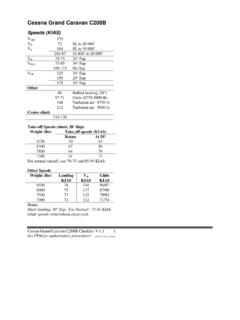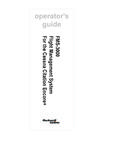Transcription of Cessna Citation 500/501 Pilot’ s Technical …
1 Cessna Citation 500/501 Type Rating Technical examination 2003, Chris R. Burger 1 Cessna Citation 500/501 Pilot s Technical examination Version 2003-09-28 Candidate Name Licence class Private/Commercial/ATP Licence number Examiner Name Licence number Capacity Centre Date 200 -- -- Mark (Pass mark is 70%) /100 = % Instructions: This is an open-book exam, for which you will need access to up-to-date Citation 500 Pilot s Operating Handbook and Technical manuals. For each question, mark the block on the answer sheet corresponding to the most correct answer. The quiz forces you to work through the handbooks. However, you must also remember most of these facts for use during flight! a b c d 1 a b c d 2 a b c d 3 a b c d 4 a b c d 5 a b c d 6 a b c d 7 a b c d 8 a b c d 9 a b c d 10 a b c d 11 a b c d 12 a b c d 13 a b c d 14 a b c d 15 a b c d 16 a b c d 17 a b c d 18 a b c d 19 a b c d 20 a b c d 21 a b c d a b c d 22 a b c d 23 a b c d 24 a b c d 25 a b c d 26 a b c d 27 a b c d 28 a b c d 29 a b c d 30 a b c d 31 a b c d 32 a b c d 33 a b c d 34 a b c d 35 a b c d 36 a b c d 37 a b c d 38 a b c d 39 a b c d 40 a b c d 41 a b c d 42 a b c d a b c d 43 a b c d 44 a b c d 45 a b c d 46 a b c d 47 a b c d 48 a b c d 49 a b c d 50 a b c d 51 a b c d 52 a b c d 53 a b c d 54 a b c d 55 a b c d 56 a b c d 57 a b c d 58 a b c d 59 a b c d 60 a b c d 61 a b c d 62 a b c d 63 a b c d a b c d 64 a b c d 65 a b c d 66 a b c d 67 a b c d 68 a b c d 69 a b c d 70 a b c d 71 a b c d 72 a b c d 73 a b
2 C d 74 a b c d 75 a b c d 76 a b c d 77 a b c d 78 a b c d 79 a b c d 80 a b c d 81 a b c d 82 a b c d 83 a b c d 84 a b c d 85 86 87 88 89 90 91 92 93 94 95 96 97 98 99 100 T T T T T T T T T T T T T T T T F F F F F F F F F F F F F F F F Cessna Citation 500/501 Type Rating Technical examination 2003, Chris R. Burger 2 Section A: Engines 1. The engines are: a. Pure jets. b. Turboprops. c. High-bypass fans. d. High-pressure turbines. 2. The two engine RPM parameters N1 and N2 are, respectively: a. Fan and high-pressure turbine RPM. b. Gas producer and low-pressure turbine RPM. c. Fan and low pressure turbine RPM. d. Accessory gearbox and high-pressure turbine RPM. 3. The combustion chamber is a reverse-flow type to: a. Decrease the amount of airflow through the engine. b. Reduce combustion temperatures. c. Reduce engine size.
3 D. Increase combustion temperature. 4. The maximum allowable transient ITT (2 s maximum) during start is: a. 580 C b. 670 C c. 680 C d. 700 C 5. The maximum allowable continuous N1 is: a. 95% b. 97% c. 99% d. 110% 6. The ignition system does not: a. Provide spark ignition at all times during normal operation. b. Provide spark ignition when starting. c. Provide spark ignition when ice protection is selected. d. Provide spark ignition when manually selected. Cessna Citation 500/501 Type Rating Technical examination 2003, Chris R. Burger 3 7. Oil brands: a. May not be mixed at all. b. May be mixed but only in an emergency. c. May be mixed provided they are both natural oils. d. May be mixed provided they are both synthetic oils. 8. The green light above each ignition switch indicates that: a. The igniter plugs are firing.
4 B. The engine combustion is sustainable. c. The igniter unit is receiving electrical power. d. Both a and b. 9. The oil level is best checked: a. Before the first flight of the morning. b. Within half an hour after flight. c. While the engine is turning. d. During routine maintenance checks. 10. The starting sequence is: a. Fully automatic. b. Semi-automatic, as the pilot has to introduce fuel at the right time. c. Manual, with the pilot having to control ignition and fuel and to turn off the starter motor at the right RPM. d. Fully automatic if an optional FADEC is installed. 11. The ITT gauge shows: a. The exhaust gas temperature. b. The temperature measured between the low-pressure and high-pressure turbines. c. The exhaust gas temperature, modified to estimate the actual ITT. d. A calculated ITT. Section B: Thrust reversers 12.
5 Thrust reversers are provided: a. On all C500s and C501s. b. As an optional extra. c. Only if a drag chute is installed. d. Only if no drag chute is installed. Cessna Citation 500/501 Type Rating Technical examination 2003, Chris R. Burger 4 13. Thrust reversers can be used: a. In flight and on the ground. b. Only for full-stop landings. c. For full-stop and touch-and-go landings. d. With a drag chute. 14. Thrust reversers are deployed by: a. An electrical system. b. A hydraulic system. c. A hydraulic system under electrical control. d. A cable-driven manual system. 15. Once the pilot has inadvertently deployed the reversers at a power setting above idle or advanced throttles during reverser retraction: a. The reversers can be freely used. b. The throttle system must undergo maintenance. c. The engines must be shut down and re-started before flight.
6 D. The reversers cannot be stowed. 16. If the thrust reverser is selected in flight: a. A squat switch will preclude deployment. b. The Master Warning will flash. c. The reverser will deploy, leading to an asymmetric condition. d. Both a and b. Section C: Fire protection 17. Pressing the LH or RH ENG FIRE PUSH button results in: a. Shutdown of fuel supply, hydraulics and electrics to and from that engine and arming the extinguishers. b. Shutdown of fuel supply, hydraulics and electrics to and from that engine and discharging the extinguisher into that engine. c. Discharging the extinguisher into the engine. d. A fire alarm. 18. During an electrical failure with the battery switch on EMER, the fire protection system: a. Works normally. b. Works normally, except that the warning lights do not illuminate. c. Is inoperative.
7 D. Can be activated through a manual override lever. Cessna Citation 500/501 Type Rating Technical examination 2003, Chris R. Burger 5 Section D: Pneumatic and vacuum 19. Vacuum is generated: a. By two pumps on the accessory gearbox of each engine. b. By an electrical vacuum pump. c. By venting bleed air overboard through an ejector. d. By a vacuum pump on the left engine only. 20. The compressed air bottle in the nose compartment: a. Provides pressure for emergency wheel brakes. b. Provides pressure for landing gear blow-down. c. Blows out if it becomes over-pressurised. d. All of the above. Section E: Flaps and flight controls 21. Speedbrakes may be used: a. Only on the ground. b. On the ground and in flight up to 176 KIAS. c. On the ground and in flight when the flaps are up. d. In all flight and ground operations.
8 22. The following flap settings are recommended for takeoff: a. 0 for all takeoffs. b. 15 for all takeoffs. c. 0 for some takeoffs, and 15 for others. d. 15 for some takeoffs, and 40 for others. 23. The following flap settings can be selected: a. 0 , 15 and 40 . b. 0 and from 15 to 40 . c. From 0 to 15 and 40 . d. From 0 to 40 . 24. Stall warning is provided by: a. An audible horn. b. A red light on the instrument panel. c. Both a and b. d. By aerodynamic buffeting. Cessna Citation 500/501 Type Rating Technical examination 2003, Chris R. Burger 6 25. On the optional angle of attack system, a reading of 1 means: a. The angle of attack for best lift/drag ratio. b. The stalling angle of attack. c. The angle of attack is 0 . d. The aircraft is in level flight. Section F: Landing gear 26. The landing gear is operated: a.
9 Electrically. b. Hydraulically. c. Hydraulically, with electric control circuits. d. Through a suitable system of linkages. 27. The gear horn will sound, and cannot be silenced by the Horn Silence button when the gear is not locked down and: a. A low power setting is used on both engines. b. A low power setting is used on both engines and 15 of flaps are selected. c. A low power setting is used on one engine, and 15 of flaps are selected. d. A low power setting is used on one engine, and 30 of flaps are selected. 28. The landing gear is kept up by: a. Hydraulic pressure. b. Mechanical uplocks. c. Pneumatic pressure. d. Electric solenoids. 29. If the landing gear mechanism burns out while the landing gear is in transit, the pilot can: a. Raise and lower the gear manually. b. Allow the gear to free fall and lock down it manually.
10 C. Blow the gear down using air pressure. d. Both b and c. Cessna Citation 500/501 Type Rating Technical examination 2003, Chris R. Burger 7 Section G: Brakes 30. When the brakes are being applied by both pilots : a. The right-seat pilot has control. b. The left-seat pilot has control. c. The pilot who applied brakes first has control. d. The pilot who applies most force has control. 31. The brake fluid reservoir is situated: a. On the hydraulic power pack. b. In the tailcone area adjacent to the oxygen filler panel. c. In the nose compartment on the right side of the front pressure bulkhead. d. Under the floorboards, forward of the main spar. 32. The park brake: a. Is self-adjusting. b. Can lose pressure if the temperature changes in cycles. c. Can simply be pulled out to engage the brakes. d. Operates with air pressure.

